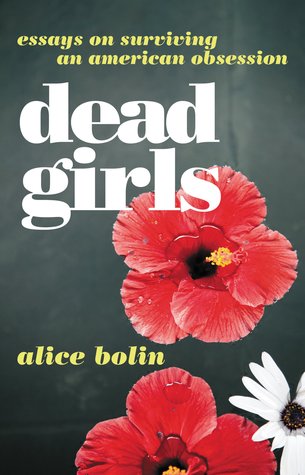Dead Girls: Essays on Surviving an American Obsession, by Alice Bolin, essays
Summary: In Dead Girls, Bolin examines the American culture’s obsession with female victims and their (both living and dead) bodies. Through examining works from essayists (like Joan Didion and James Baldwin), pop culture icons, and television shows, Bolin critiques both our fascination and our roles as consumer and creators.
Non-fiction isn’t really my preferred reading material.
It tends to be difficult for me to slog through and remember anything except the stories used as illustrations. (I had to read enough NF/literary criticism in graduate school, thank you.) But I was intrigued by the title and premise of Bolin’s essay collection. “Dead girls”? Sounds like something a crime/suspense novelist should read!
For the most part, Bolin kept my attention.
What didn’t work for me:
1. The L.A.-focused essays
Bolin moved to L.A. when she was 25. It was the most interesting thing she’d ever done, she informs us.
I’ve never been to L.A. or understood the fascination with this particular city. (That’s not a knock against L.A. residents. I just prefer big cities that are more piled-on-top-of-each other than sprawled.) There were parts that I felt just as lost as Bolin driving down on the L.A. freeways after a lifetime in the rural Midwest. She references places that I’ve never heard of (except in Michael Connolly’s novels), and I had a hard time understanding why she wanted to live there at all. But that’s more about me as a reader than her as a writer.
2.The Joan Didion obsession
This is another it’s-me-not-you issue. I’ve only read one Didion book, a novel, and didn’t care for it. Bolin knows Didion’s work thoroughly and freely references her work, her writing circles & scene, and the subject of Didion’s critiques. I understood some of Bolin’s points, though; though I can’t find the exact quote, I understand what she means when she says that finding out Didion was wrong was like finding out her mother lied. Finding out one’s literary hero is flawed, human after all, and holds a vision that is just that–a vision, a point of view that doesn’t encompass all other points of view.
I was lost (think L.A. freeway lost) in the essays dealing with Didion. Those who do know her work will probably understand these essays better.
3. The other cultural references
My problems with the Didion-focused essays are similar to my problems elsewhere. If I knew the cultural/literary/film references, I could follow Bolin’s writing; likewise, if she stuck to one unfamiliar reference, I could usually follow along. But if there was more than one unfamiliar person/book/film being referenced, compared and contrasted, etc., I was lost. The essay about the 1970s art scene, for example, may have been brilliant but it was lost on me.
When she critiques books like Beloved, I was much more comfortable. I know the novel and understood what she was saying.
What worked for me
1. The beginning section (“the Dead Girl Show”) and the intro
This is the reason I read the book. In American noir (both film and book), there’s an obsession with the “dead girl”: she’s never really a character in the book. She’s only a victim. Other characters must perpetrate, investigate, and respond to her death. In other words, she’s only a memory. Passive. There’s no redemption possible for the dead girl but there is for the person–almost always male–solving her murder.
Bolin argues that the power of this narrative is two-fold.
- It reflects the idea that girls are wild, vulnerable, and must be “protected from the power of their own sexualities” (pg.16). Their bodies are both a source and target of sexual depravity.
- It insists that we “trust no dad.” Fathers and other male authorities have an interest in controlling girls’ bodies.
(From my experience, noir’s not the only genre dealing with the first idea. I’ve seen versions of them in almost every idea-source I’ve encountered: theology, education, culture, politics across the spectrum. The second idea is unacknowledged but still present. It’s no wonder that noir specifically–and the crime genre in general–uses them.)
Bolin critiques the concept that crimes are turned into stories.
For example, in TV shows about murder, the victim–a literal dead girl–is generic. The focus is on the detective work and the criminal. She writes,
“Our cultural obsession with murder stories and the criminal justice system is a prime example of the impulse to narrativize a reality that is basically unexplainable.” Dead Girls, pg. 126
I don’t agree that it’s entirely unexplainable–the theological concept of “evil” takes care of it for me, to an extent–but the cultural need to turn everything into a story rings true.
Later, she writes,
“For both the media covering a case and the district attorney” (I would add the defense attorney as well) “a murder is a story to be sold, whether to a movie studio, a publishing house, or a jury.” Dead Girls, pg. 126
The essays here are the strongest in the book.
There is so, so much more I could discuss but this review would be book-length. She writes about psychopathic serial killers (not larger than life but smaller), Ruby Ridge and the hidden anarchy of remote environments, authors like Sherman Alexie and Jess Walter, and the popular wisdom that it’s always the “husband did it” (statistically, it’s true).
2. Her writing persona
Though Bolin’s “self” as she writes it can come across as overly naive and self-focused, I still liked her. As written, she’s the person for whom adulting classes were invented. She mentions accidentally throwing her new license in the garbage more than once, listening to Taylor Swift songs on the bus and crying over them, and fear that it isn’t the real her who loves her first boyfriend but “the girlfriend I was pretending to be” (pg. 241). She’s a bit like the “pop cliche irony” that she critiques: ironic, self-deprecating, darkly humorous.
3. Her essays about her father’s crime novel obsession.
Her father sounds quirky, I’m familiar with the late Stieg Larsson’s work, and so this essay was relatively fun to read.
Overall, I enjoyed Dead Girls, even if it wasn’t quite what I expected. 3 1/2 stars.
This review also appears on Goodreads.
Have you read this book? What are your thoughts? Have you encountered other books on this subject? Tell me about them!

